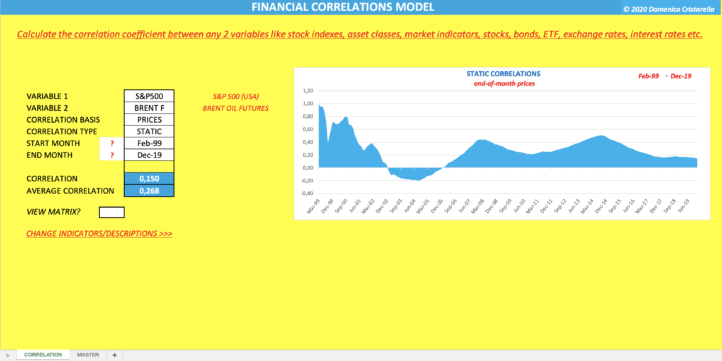Financial Correlations Model Template in Excel
Calculate the correlation coefficient between any two variables, whether they are stock indexes, asset classes, market indicators, individual securities, commodities, currencies, interest rates, or anything else that can be tracked numerically.

The model calculates static or rolling correlations (12, 24, 36, 48, 60 months) for the given time period, based either on end-of-month values or monthly returns, going back to Dec. 1995. Including a chart to visualize changes over time. 29 indicators included. You can replace any of them with the most appropriate ones for your analysis by uploading historical values in the “Master” sheet.
Correlation statistically measures the degree of relationship between two variables in terms of a correlation coefficient that lies anywhere between +1.0 and -1.0. When it comes to diversified portfolios, correlation represents the degree of relationship between price (returns) movements of different assets included in the portfolio.
A correlation of +1.0 means prices (returns) move totally in tandem (perfect positive correlation); a correlation of -1.0 means that prices (returns) move in completely opposite directions (perfect negative correlation). A correlation of 0 means the movement of one asset has no effect on the movement of the other asset. Well, diversified portfolios should include uncorrelated or inversely correlated assets.
IMPORTANT NOTE:
Depending on computer capacity, the file may take between 20 and 30 seconds to download.
This model template comes as a PREMIUM version in .xlsx file type, which can be opened using MS Excel.
Similar Products
Other customers were also interested in...
Multi-Member Investment Fund Portfolio and Distrib...
A fund management tool to track many positions over time as well as distributions to up to 20 member... Read more
Savings Bank Financial Model Excel Template
Savings Bank Budget Template There's power in Cash Flow Projections and the insight they can provide... Read more
Alternative Investment Company Valuation Template
Alternative Investment Company Valuation: All-In-One Model for Private Equity, Asset Management, and... Read more
Financial Advisor / Financial Planner Financial Pr...
5-Year 3-Statement Excel projection model for Financial Advisor / Financial Planner business generat... Read more
Amortization Schedules Template (Loans, Mortgages,...
User friendly template including Amortization Schedules for Loans, Mortgages, Operating and Finance ... Read more
Financial Advisors Agency Financial Model Excel Te...
Shop Financial Advisors Agency Pro-forma Template. Creates 5-year financial projection and financial... Read more
Legal Services Financial Model Excel Template
Buy Legal Services Financial Plan. Based on years of experience at an affordable price. Generates 5-... Read more
Private Equity Fund Model (Investor Cashflows)
Private Equity Financial Model to analyze fund cashflows and returns available to Limited Partners (... Read more
Consulting Firm Financial Model – Dynamic 10 Yea...
Financial Model providing a dynamic up to 10-year financial forecast for a startup or existing Consu... Read more
You must log in to submit a review.
















